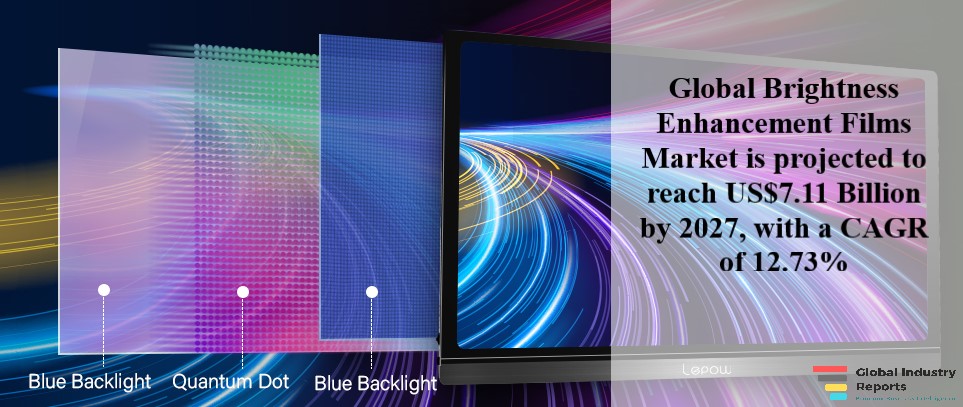Report Overview
- Understand the latest market trends and future growth opportunities for the Brightness Enhancement Films industry globally with research from the Global Industry Reports team of in-country analysts – experts by industry and geographic specialization.
- Key trends are clearly and succinctly summarized alongside the most current research data available. Understand and assess competitive threats and plan corporate strategy with our qualitative analysis, insight, and confident growth projections.
- The report will cover the overall analysis and insights in relation to the size and growth rate of the “Global Brightness Enhancement Films Market” by various segments at a global and regional level for the 2010-2027 period, with 2010-2021 as historical data, 2021 as a base year, 2022 as an estimated year and 2022-2027 as forecast period.
COVID-19 Impact on Brightness Enhancement Films Market
- With the world having to adapt quickly to social distancing, the avoidance of touching surfaces where viruses can be transmitted, and the increased monitoring of people’s vital signs, it’s no wonder the display market gained a boost increase in work-from-home concepts adding never seen demand for personal laptops and in-home entertainment electronics.
- Increased demand for medical instruments with digital displays drove the demand during the pandemic.
Description:
- The global market for Brightness Enhancement Films estimated at US$3.9 Billion in the year 2022, is projected to reach a revised size of US$7.1 Billion by 2027, with a CAGR of 12.73% over the analysis period.
- The United States represents the largest regional market for Brightness Enhancement Films and is projected to reach US$2.9 Billion by 2027. China is expected to spearhead growth and emerge as the fastest-growing regional market with a CAGR of 10.4% over the analysis period. all favoring growth.
- A large portion of wearable technology is in the nature of consumer electronics and healthcare and medicine. This region has several people exposed to the trend of adopting developing technologies, especially those people which fall within a range of good income.
- South Korea represents the largest market worldwide. China ranks as the fastest-growing market with a CAGR of 10.5% over the analysis period. The upward momentum in the adoption of TFT-LCDs, in line with growing demand for mobile phones, notebooks, and LED TVs, is creating parallel demand for BELM Films in the vast Chinese electronics market.
- At present, core components such as light management films are available in numerous variants. Taiwan, South Korea, and China have emerged as the leading providers of backlights and display panels. Demand for Backlight Units (BLUs) remains strong driven primarily by the growing demand for notebooks, televisions, and monitors. This in turn contributes to the increased demand for backlight films. The backlight sector particularly is witnessing intense activity, with manufacturers engaged in developing various combinations of the prism, diffusion, and micro-lens films.
The Brightness Enhancement Films Report Includes:
- The report provides a deep dive into details of the industry including definitions, classifications, and industry chain structure.
- Analysis of key supply-side and demand trends.
- Detailed segmentation of international and local products.
- Historic volume and value sizes, company, and brand market shares.
- Five-year forecasts of market trends and market growth.
- Robust and transparent research methodology conducted in-country.
- Qualitative and quantitative analysis of the market based on segmentation involving both economic as well as non-economic factors.
- Provision of market value (USD Billion) data for each segment and sub-segment.
- Analysis by geography, region, Country, and its states.
- A brief overview of the commercial potential of products, technologies, and applications.
- Company profiles of leading market participants dealing in products category.
- Description of properties and manufacturing processes.
- marketed segments on the basis of type, application, end users, region, and others.
- Discussion of the current state, setbacks, innovations, and future needs of the market.
- Examination of the market by application and by product sizes; utility-scale, medium scale and small-scale.
- Country-specific data and analysis for the United States, Russia, China, Germany, United Kingdom, France, Japan, Israel, Saudi Arabia, South Korea, United Arab Emirates, Canada, Switzerland, Australia, India, Italy, Turkey, Qatar, Sweden, Spain, Belgium, Netherlands, Norway, Singapore, Egypt, Denmark, Austria, Vietnam, Brazil, Argentina, Mexico, South Africa, and others.
- Coverage of historical overview, key industrial development and regulatory framework.
- Analysis of competitive developments, such as contracts & agreements, expansions, new product developments, and mergers & acquisitions in the market.
- A look at the opportunities in the market for stakeholders and provide a competitive landscape of the market leaders.
Reports Scope and Segments:
| Report Attribute | Details |
| Market size value in 2022 | USD 3.9 billion |
| Revenue forecast in 2027 | USD 7.1 billion |
| Growth Rate | CAGR of 12.73% from 2022 to 2027 |
| Base year for estimation | 2021 |
| Historical data | 2015 – 2021 |
| Forecast period | 2022 – 2027 |
| Quantitative units | Revenue in USD million and CAGR from 2021 to 2027 |
| Report coverage | Revenue forecast, company ranking, competitive landscape, growth factors, trends, DROT Analysis, Market Dynamics and Challenges, and Strategic Growth Initiatives |
| Segments covered | Product, Component, Technology, Application, Region |
| Regional scope | North America; Europe; Asia Pacific; Latin America; Middle East and Africa and rest of the world |
| Country scope | United States, Russia, China, Germany, United Kingdom, France, Japan, Israel, Saudi Arabia, South Korea, United Arab Emirates, Canada, Switzerland, Australia, India, Italy, Turkey, Qatar, Sweden, Spain, Belgium, Netherlands, Norway, Singapore, Egypt, Denmark, Austria, Vietnam, Brazil, Argentina, Mexico, South Africa, and others. |
| Key companies profiled | 3M Company, Dai Nippon Printing Co., Ltd., DuPont, EFUN Technology Co. Ltd., Fusion Optix, Inc., Ltd., Jia Wei Lifestyle, Inc., Kolon Industries, Inc., LG Chem Ltd., LMS Co., Ltd., MNTech Co., Ltd., Nitto Denko Corp., SABIC Innovative Plastics, Shinwha Intertek Corp., SKC Hitech & Marketing Co., Ltd., UBright Optronics Corp., Wah Hong Industrial Corp., WaveFront Technology, Inc., and ZEON Corp. and others. |
| Customization scope | Free report customization (equivalent up to 10 analyst’s working days) with purchase. Addition or alteration to country, regional & segment scope. |
| Report Format | PDF, PPT, Excel & Online User Account |
Brightness Enhancement Films by Category
Based on the type:
- Multi-Function Prism
- Reflective Polarizer
- Diffuser Film
- Normal Prism
- Single Layer
- Multi-Layer
- Others
Based on application:
- Monitors
- Handhelds
- TVs
- Notebooks
- Other Devices
Key Market Players
3M Company, Dai Nippon Printing Co., Ltd., DuPont, EFUN Technology Co. Ltd., Fusion Optix, Inc., Ltd., Jia Wei Lifestyle, Inc., Kolon Industries, Inc., LG Chem Ltd., LMS Co., Ltd., MNTech Co., Ltd., Nitto Denko Corp., SABIC Innovative Plastics, Shinwha Intertek Corp., SKC Hitech & Marketing Co., Ltd., UBright Optronics Corp., Wah Hong Industrial Corp., WaveFront Technology, Inc., and ZEON Corp., among others.
Top 5 Brightness Enhancement Films Companies by Shipment Volume, Market Share, and Year-Over-Year Growth, Q1 2022 (shipments in millions)
| Company | 1Q22 Shipments |
1Q22 Market Share |
1Q21 Shipments |
1Q21 Market Share |
Year-Over-Year Growth |
| 1. 3M Company | 32.1 | 30.5% | 30.1 | 27.7% | 6.6% |
| 2. Mitsubhi Rayon | 10.9 | 10.3% | 12.1 | 11.1% | -9.9% |
| 3. Fusion Optix | 9.8 | 9.3% | 12.9 | 11.9% | -23.8% |
| 4. Nitto Denko Corp | 7.7 | 7.3% | 8.6 | 7.9% | -10.8% |
| 5. SABIC | 3.2 | 3.0% | 3.0 | 2.8% | 5.2% |
| Others | 41.7 | 39.6% | 41.9 | 38.6% | -0.5% |
| TOTAL | 105.3 | 100.0% | 108.6 | 100.0% | -3.0% |
Recent Developments
- 3M Company introduced dual brightness enhancement films to help optics and display manufacturers to meet the requirements to modify display features in various consumer electronics products.
- DuPONT Electronics & Imaging is expanding by investing US$ 220 million in the production plant in Ohio, U.S. The new production facility will increase the company’s production of Pyralux flexible circuit materials and Kapton polyimide film.
After Sales Support
- Every updated edition of the report and full data stack will be provided at no extra cost for 24 months.
- Latest 2021 base year report.
- No user limitation for the report. Unlimited access within the organization.
- Unrestricted post-sales support at no additional cost
- Free report customization (equivalent up to 10 analyst’s working days) with purchase. Addition or alteration to country, regional & segment scope
- Global Industry Reports will support your post-purchase for a period of 24 months to answer any of your queries related to the following market and to provide you any more data needed, for your analysis.
- Option to purchase regional or some selected Chapters from the report.
This report answers
- What is the market size of Brightness Enhancement Films Globally and in your country?
- Which are the leading brands?
- How are products distributed?
- How is the rise of e-commerce changing the retail landscape?
- How has COVID-19 and accordant macroeconomic and retail disruption impacted consumer demand?
- How are considerations such as urban development and the rise in single-person households driving sales growth?
- Where is technology taking the market? Which products are pioneering growth? Which face obsolescence?
- Where is future growth expected to be most dynamic?










